Bennemann K.H., Ketterson J.B. Superconductivity: Volume 1: Conventional and Unconventional Superconductors; Volume 2: Novel Superconductors
Подождите немного. Документ загружается.

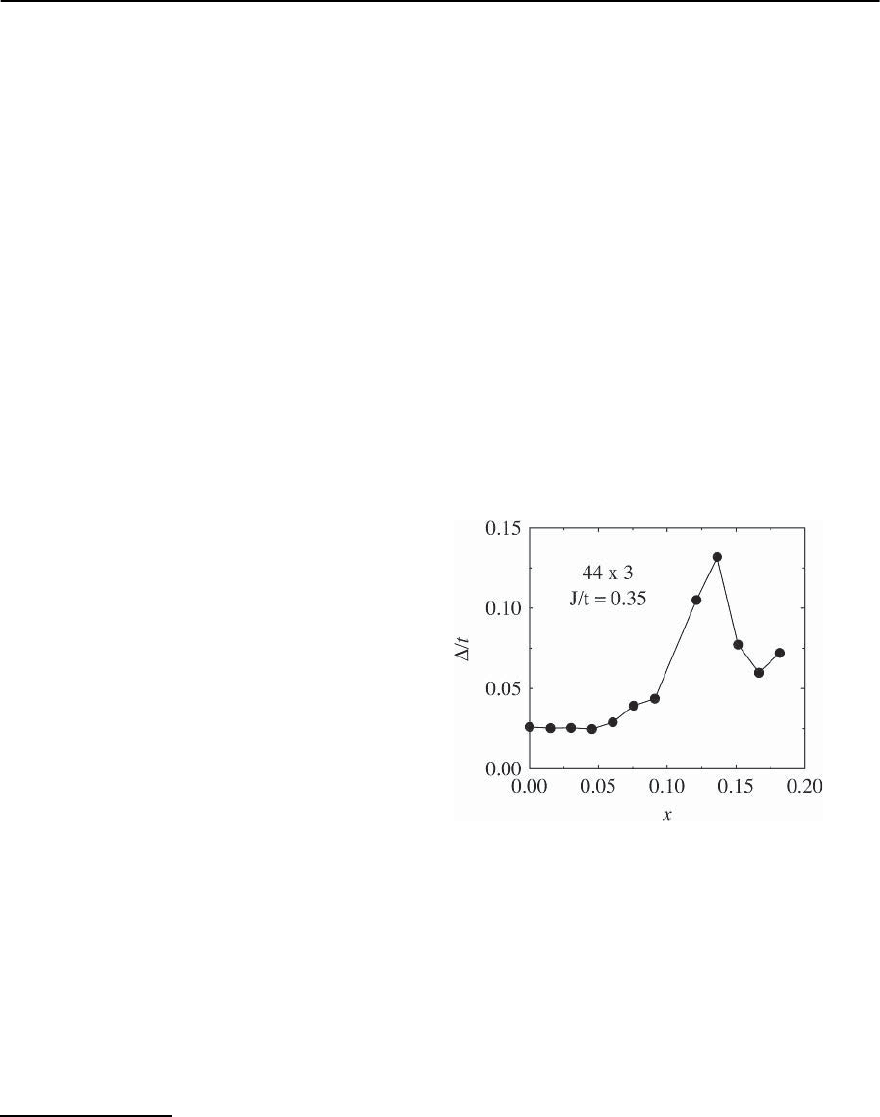
21 Concepts in High Temperature Superconductivity 1291
inance of the d
x
2
−y
2
channel is universally shared by
all models over the entire range of doping that has
been studied. (See Sect. 21.10.3 for a discussion of
this phenomenon in the 2 × 2 plaquette.)
The doping dependence of the pair binding en-
ergy roughly follows the spin gap in various versions
of the two leg ladder as shown in Fig. 21.30. The cor-
relation function D(l) of the pair field
†
i
=(c
†
i1↑
c
†
i2↓
− c
†
i1↓
c
†
i2↑
) , (21.120)
exhibits behavior consistent with a power law de-
cay [191,372,374–376]
D(l)=
i+l
†
i
∼l
−
. (21.121)
There exists less data concerning its doping depen-
dence,but from the relevant studies [191,372]we can
conclude that the pair correlations increase from the
undoped system to a maximum at x ∼ 0.0625 and
then decrease when more holes are added to the sys-
tem.
Details and their importa nce
Both the spin gap and the pairing correlations in
doped Hubbard and t − J ladders can be apprecia-
bly enhanced by slight generalizations of the models.
For example, the exponent in Eq. (21.121), which
depends on the coupling strengths U/t or J/t and
the doping level x, is also sensitive to the ratio of
the hopping amplitudes between neighboring sites
onarungandwithinachaint
⊥
/t.Byvaryingthis
parameter, the exponent can be tuned over the
range 0.9 ≤ ≤ 2.1. In particular, for x =0.0625
and intermediate values of the (repulsive) interac-
tion 5 ≤ U/t ≤ 15, it can be made smaller than
1 [191]; see Fig. 21.14. This is significant since, as we
saw in Sect. 21.5.1, whenever < 1 the supercon-
ducting susceptibility is the most divergent among
the various susceptibilities of the ladder. Adding a
nearest neighbor exchange coupling, J,toH
U
also
leads to stronger superconducting signatures owing
to an increase in the pair mobility and binding en-
ergy [378].
Anotherlessoninhumility
The moral here is that details are important as far as
they reveal the nonuniversal properties of the Hamil-
tonians that we study, and indicate relevant direc-
tions in model space. It should also imprint on us a
sense of humility when attempting to fit real world
data with such theoretical results.
Odd and want a gap? –Dope!
We already noted that, in contrast to the two leg lad-
der, the three leg system does not possess a spin gap
at half filling. This situation persists up to hole dop-
ing of about x =1−n =0.05, as can be seen in
Fig. 21.31.
23
However, with moderate doping a spin
gap is formed which reaches a maximum value at a
doping level of x =0.125.Forthe system shown here,
with J/t =0.35, the gap is only 20 percent smaller
than that of the undoped two leg Heisenberg lad-
der. Upon further doping, the spin gap decreases and
possibly vanishes as x gets to be 0.2 or larger.
Fig. 21.31. Spin gap for a 44 ×3 ladder with open boundary
conditions and J/t =0.35 as a function of doping. (From
White and Scalapino [379])
Thesamegoesforpairing.
The establishment of a spin gap is concurrent with
the onset of pairing correlations in the system.While
two holes introduced into a long, half filled three
chain ladder do notbind [338],indicationsof pairing
emerge as soon as the spin gap builds up [379,380].
As an example, Fig. 21.32 plots the pair field–pair
23
The nonvanishing spin gap in this region is presumably a finite size effect; see Fig. 21.28.
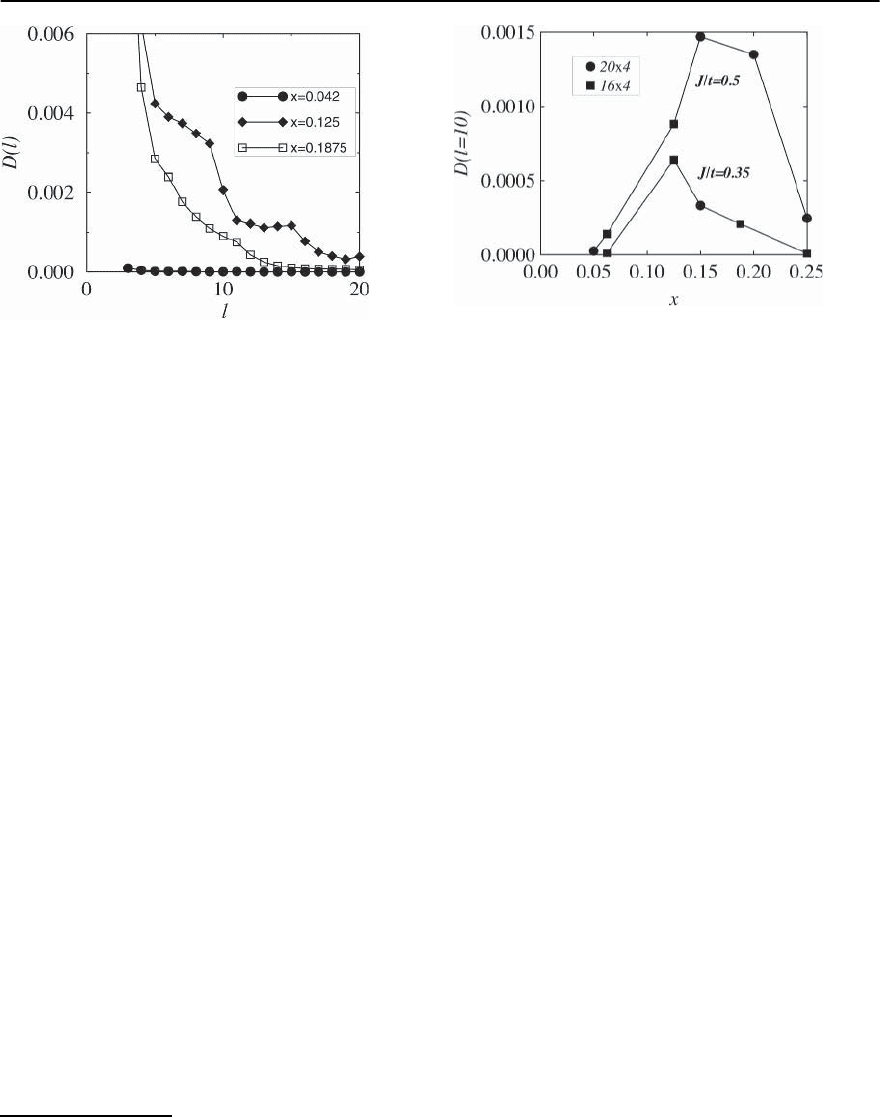
1292 E.W. Carlson et al.
Fig. 21.32. The d
x
2
−y
2 pair field correlations D(l)forthree
different densities, calculated on 32 × 3(x =0.1875) and
48 × 3(x =0.042, x =0.125) open t − J ladders with
J/t =0.35.(From White and Scalapino [379])
field correlation function of Eq. (21.121) for various
values of the hole doping, defined with
†
i
= c
†
i,2↑
(c
†
i+1,2↓
+ c
†
i−1,2↓
− c
†
i,1↓
− c
†
i,3↓
)−(↑↔↓)
(21.122)
which creates a d
x
2
−y
2
pair around the ith site of the
middle leg (the leg index runs from 1 to 3).
24
In the
regime of low doping x ≤ 0.05, the pair field corre-
lations are negligible.However,clear pair field corre-
lations are present at x =0.125, where they are com-
parable to those in a two leg ladder under similar
conditions.The pair field correlations are less strong
at x =0.1875; they follow an approximate power law
decay as a function ofthe distance [375,379].(The os-
cillations in D(l) are produced by the open boundary
conditions used in this calculation.) This behavior
can be understood from strong coupling bosoniza-
tionconsiderations[20]in whichthetwoevenmodes
(with respect to reflection about the center leg) form
a spin gapped two leg ladder and for small doping
the holes enter the odd mode giving rise to a gap-
less one-dimensional electron gas. As the doping in-
creases, pair hopping between the two subsystems
may induce a gap in the gapless channel via the spin
gap proximity effect [20].
Increasing the number of legs from three to four
leads to behavior similar to that exhibited by the
two leg ladder. The system is spin gapped and two
Fig. 21.33. The d
x
2
−y
2 pair field correlation D(l)atasepara-
tion of l = 10 rungs as a function of doping x,for20× 4
and 16 × 4 open ladders with J/t =0.35 and 0.5. (From
White and Scalapino [381])
holes in a half filled four leg ladder tend to bind.
The pair exhibits features common to all pairs in an
antiferromagnetic environment, including a d-wave-
like symmetry [338]. Further similarity with the two
leg ladder is seen in the d-wave pair field correla-
tions D(l). Figure 21.33 shows D(l = 10) for a t − J
four leg ladder as a function of doping (extended s-
wave correlations are much smaller in magnitude).
The pairing correlations for J/t =0.5 increase with
doping, reaching a maximum between x =0.15 and
x =0.2, and then decrease.
Four legs are good; two legs are better.
The magnitude of the correlations near the maxi-
mum is similar to that of a two leg Hubbard ladder
with U =8t (corresponding to J ∼ 4t
2
/U =0.5)
with the same doping, but smaller than the maxi-
mum in the two leg ladder which occurs at smaller
doping [191,372]. For J/t =0.35 the peak is reduced
in magnitude and occurs at lower doping. The be-
havior of D(l) near the maximum is consistent with
power law decay for short to moderate distances but
seems to fall more rapidly at long distances (perhaps
even exponentially [382]).
Lastly, we present in Fig. 21.34 the response of a
few ladder systems to a proximity pairing field
H
1
= d
i
(c
†
i,↑
c
†
i+ˆy,↓
− c
†
i,↓
c
†
i+ˆy,↑
+ h.c.) , (21.123)
24
There also exists a small s-wave component in the pair field due to the one-dimensional nature of the cluster.
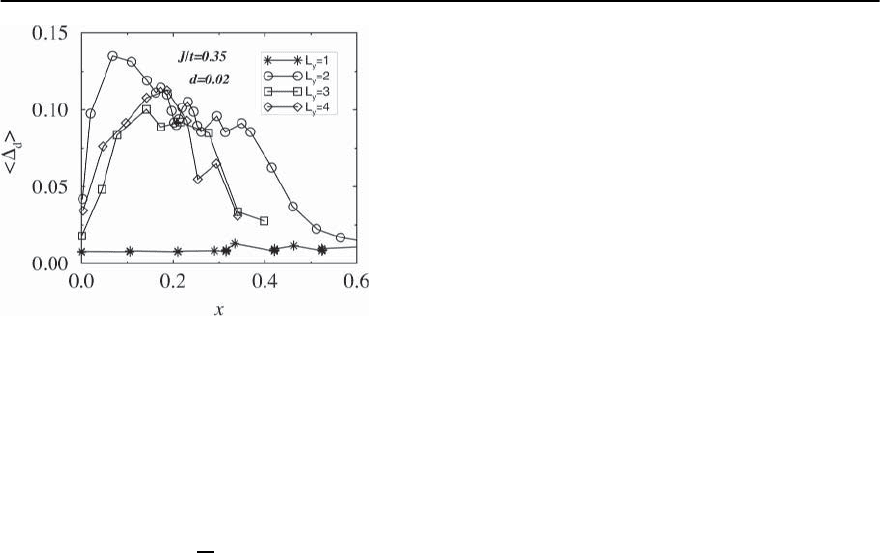
21 Concepts in High Temperature Superconductivity 1293
Fig. 21.34. The d
x
2
−y
2 pairing response to a proximity pair
field operator as a function of doping for a single chain and
two, three, and four leg ladders. For the single chain, near
neighbor pairing is measured. (From White and Scalapino
[379])
which adds and destroys a singlet electron pair along
theladder.Theresponseisgivenbytheaveraged
x
2
−y
2
pair field
d
=
1
N
i
i
, (21.124)
with
i
defined in Eq. (21.120). We see that the pair
field response tends to decrease somewhat with the
width of the system but is overall similar for the two,
three and four leg ladders.We suspect it gets rapidly
smaller for wider ladders.
Phase Separation and Stripe Formation in Ladders
We now address the issue of whether there is any ap-
parent tendency to form charge density and/or spin
density wave order in ladder systems, and whether
there is a tendency of the doped holes to phase
separate. Since incommensurate density-wave long-
range order,likesuperconducting order,isdestroyed
by quantum fluctuations in one dimension, we will
again be looking primarily at local correlations,
rather than actual ordered states. Of course, we have
in mind that local correlations and enhanced sus-
ceptibilities in a one-dimensional context can be in-
terpreted as indications that in two dimensions true
superconductivity, stripe order, or phase separation
may occur.
Phase Separation:
Phase separation was first found in the one-
dimensional chain [383, 384] and subsequently in
the two leg ladder [385–387]. As a rule, the phase
separation line has been determined by calculating
the coupling J at which the compressibility diverges.
(See, however, [352].) This is in principle an incor-
rect criterion. The compressibility only diverges at
the consolute point. Thermodynamically appropri-
ate criteria for identifying regimes of phase sepa-
ration from finite size studies include the Maxwell
construction (discussed explicitly in Sect. 21.12, be-
low),and measurements of the surface tension in the
presence of boundary conditionsthat forcephase co-
existence. The divergent compressibility is most di-
rectly related to the spinodal line, which is not even
strictly well defined beyond mean field theory. Thus,
while in many cases the phase diagrams obtained in
this way may be qualitatively correct, they are always
subject to some uncertainty.
More recently Rommer, White, and Scalapino
[388] have used DMRG methods to extend the study
to ladders of up to six legs. Since these calcula-
tions are carried out with open boundary conditions,
which break the translational symmetry of the sys-
tem, they have used as their criterion the appear-
ance of an inhomogeneous state with a hole rich re-
gion at one edge of the ladder and hole free regions
near the other,which is a thermodynamically correct
criterion for phase separation. However, where the
hole rich phase has relatively low hole density, and
in all cases for the six leg ladder, they were forced
to use a different criterion which is not thermody-
namic in character, but is at least intuitively appeal-
ing. From earlier studies (which we discuss below) it
appears that the “uniform density” phase, which re-
places the phase separated state for J/t less than the
criticalvalueforphase separation,is a“striped”state,
in which the holes congregate into puddles (identi-
fied as stripes) with fixed number of holes, but with
the density of stripes determined by the mean hole
density on the ladder. With this in mind, Rommer
et al. computed the interaction energy between two
stripes, and estimated the phase separation bound-
ary as the point at which this interaction turns from
repulsive to attractive. The results, summarized in
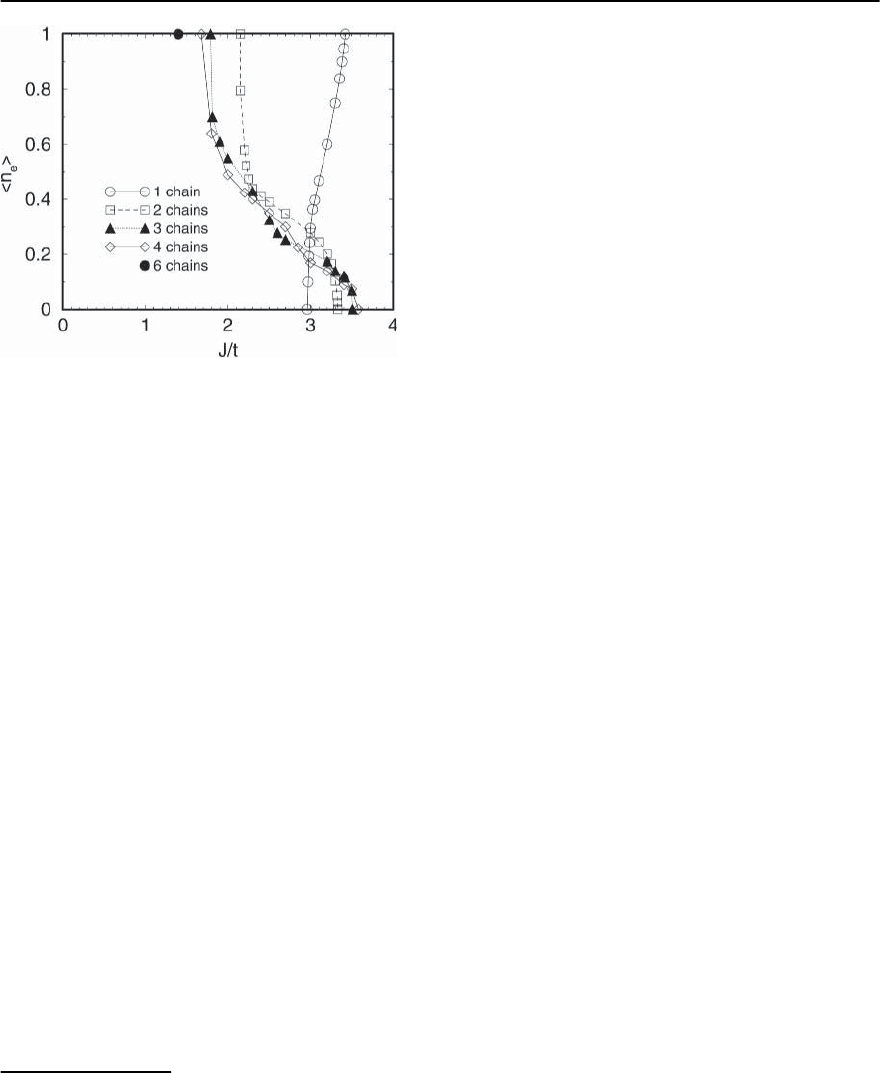
1294 E.W. Carlson et al.
Fig. 21.35. Boundary to phase separated region in t − J lad-
ders. Open boundary conditions were used in both the leg
and rung directions except for the six leg ladder where pe-
riodic boundary conditions were imposed along the rung.
Phase separation is realized to the right of the curves. n
e
is the total electron density in the system. (From Rommer
et al. [388])
Fig. 21.35, agree with the thermodynamically deter-
mined phase boundary where they can be compared.
Ladders phase separate for large enough J/t.
For large enough values of J/t,boththesinglechain
and the ladders are fully phase separated into a
Heisenberg phase (n
e
= 1) and an empty phase
(n
e
= 0). However, the evolution of this state as J/t
is reduced is apparently different for the two cases.
For the chain,the Heisenberg phase is destroyed first
by holes that diffuse into it; this presumably reflects
the fact that hole motion is not significantly frus-
trated in the single chain system. In the ladders, on
the other hand, the empty phase is the one that be-
comes unstable due to the sublimation of electron
pairs from the Heisenberg region. This difference
is evident in Fig. 21.35 where the phase separation
boundary occurs first at high electron density in the
chain and high hole density in the ladders. It is also
clear from looking at this figure that the value of J/t
at which phase separation first occurs for small elec-
tron densities is hardly sensitive to the width of the
ladder. However, as more electrons are added to the
system (removing holes),phaseseparation is realized
for smaller values of J/t in wider ladders. Whether
this is an indicationthat phase separation takes place
at arbitrarily small J/t for small enough hole densi-
ties in the two-dimensional system is currently under
debate, as we discuss in Sect. 21.11.2.
“Stripes” in Ladders: Stripes appear at smaller J/t.
At intermediate valuesof J/t,andnot too close to half
filling,the doped holes tend to segregate into puddles
which straddle the ladders, as is apparent from the
spatial modulation of the mean charge density along
the ladder. Intuitively, we can think of this state as
consisting of an array of stripes with a spacing which
is determined by the doped hole density. From this
perspective, the total number of doped holes associ-
ated with each puddle, N
puddle
= %L, is interpreted as
arising from a stripe with a mean linear density of
holes, %, times the length of the stripe, L.
25
(L is also
the width of the ladder.) In the thermodynamic limit,
long wavelength quantum fluctuations of the stripe
array would presumably result in a uniform charge
density, but the ladder ends, even in the longest sys-
tems studied to date,are a sufficiently strong pertur-
bation that they pin the stripe array [389].In two and
three leg ladders, the observed stripes apparently al-
ways have % = 1. For the four leg ladder, typically
% = 1, but under appropriate circumstances (espe-
cially for x =1/8), % =1/2 stripes are observed.
In six and eight leg ladders, the charge density os-
cillations are particularly strong, and correspond to
stripes with % =2/3 and 1/2, respectively. Various
arguments have been presented to identify certain
of these stripe arrays as being “vertical” ( i.e. pref-
erentially oriented along the rungs of the ladder) or
“diagonal” ( i.e. preferentially oriented at 45
o
to the
rung), but these arguments, while intuitively appeal-
ing, do not have a rigorous basis.
We will return to the results on the wider ladders,
below,where we discuss attempts to extrapolatethese
results to two dimensions.
25
For instance, on a long, N site, 4 leg ladder with 4n holes, where n N, one typically observes n or 2n distinct peaks
in the rung-averaged charge density, which is then interpreted as indicating a stripe array with % =1or% =1/2,
respectively.

21 Concepts in High Temperature Superconductivity 1295
21.11.2 Properties of the Two-Dimensional t − J and
Hubbard Models
It is a subtle affair to draw conclusions about the
properties of the two-dimensional Hubbard and t −J
models from numerical studies of finite systems.The
present numerical capabilities do not generally per-
mit a systematic finite size scaling analysis. As a re-
sult, extrapolating results from small clusters with
periodic boundary conditions, typically used when
utilizingMonte Carlo or Lanczostechniques,orfrom
strips with open boundary conditions as used in
DMRG studies, is susceptible to criticism [355,359].
It comes as no surprise then that several key issues
concerning the ground state properties of the two-
dimensional models are under dispute. In the fol-
lowing we present a brief account of some of the
conflicting results and views. However, at least two
things do not seem to be in dispute: 1) there is a
strong tendency for doped holes in an antiferromag-
net to clump in order relieve the frustration of hole
motion [390], and 2) where it occurs, hole pairing
has a d
x
2
−y
2
character. Thus, in one way or another,
the local correlations that lead to stripe formation
and d -wave superconductivity are clearly present in
t − J-like models!
Phase Separation and Stripe Formation
E verybody agrees on the phase separa tion boundary
for x ∼ 1.
The question of phase separation in the t − J model
has been addressed by a number of studies. Most of
them agree on the behavior in the regime of very
low electron density n
e
=1−x 1. The critical
J/t value for phase separation at vanishingly small
n
e
was calculated very accurately by Hellberg and
Manousakis [391] and was found to be J/t =3.4367.
However, there are conflicting results for systems
close to half filling (n
e
∼ 1) and with small t − J.
This is the most delicate region where high numeri-
cal accuracy is hard to obtain. Consequently, there is
no agreement on whether the two-dimensional t − J
model phase separates for all values of J/t at suffi-
ciently low hole doping x.
The situation for x ∼ 0 is murkier, but. . .
Emery et al. [392,393] presented a variational argu-
ment (recently extended and substantially improved
by Eisenberg et al. [394]) that for J/t 1 and for x
less than a critical concentration, x
c
∼
√
J/t, phase
separation occurs between a hole free antiferromag-
netic and a metallic ferromagnetic state. Since for
large J/t there is clearly phase separation for all x ,
they proposed that for sufficientlysmall x, phase sep-
aration is likely to occur for all J/t. To test this, they
computed the ground state energy by exact diagonal-
ization of 4 × 4dopedt − J clusters. If taken at face
value and interpreted via a Maxwell construction,
these results imply that for any x < 1/8, phase sepa-
ration occurs at least for all J/t > 0.2. Hellberg and
Manousakis [352,361] calculated the ground state
energy on larger clusters of up to 28 × 28 sites us-
ing Green function Monte Carlo methods. By imple-
menting a Maxwell construction, they reached the
similar conclusion that the t − J model phase sep-
arates for all values of J/t in the low hole doping
regime.
On the other hand, Putikka et al. [395] studied
this problem using a high temperature series expan-
sion extrapolated to T = 0 and concluded that phase
separation only occurs above a line extending from
J/t =3.8 at zero filling to J/t =1.2 at half filling. In
other words, they concluded that there is no phase
separation for any x so long as J/t < 1.2. Exact di-
agonalization results for the compressibility and the
binding energy of n-hole clusters in systems of up to
26 sites by Poilblanc [396] were interpreted as sug-
gesting that the ground state is phase separated close
to half filling only if J/t > 1. Quantum Monte Carlo
simulations of up to 242 sites using stochastic recon-
figurationbyCalandra etal.[397] havefoundaphase
separation instability for J/t ∼
0.5
at similar doping
levels, but no phase separation for J/t < 0.5, while
earlier variational Monte Carlo calculations [398] re-
ported a critical value of J/t =1.5. Using Lanczos
techniques to calculate the ground state energy on
lattices of up to 122 sites, Shih et al. [399,400] esti-
mate the lower critical value for phase separation as
J/t =0.3−0.5, a somewhat lower bound than previ-
ously found using similar numerical methods [401].
Finally, DMRG calculations on wide ladders with
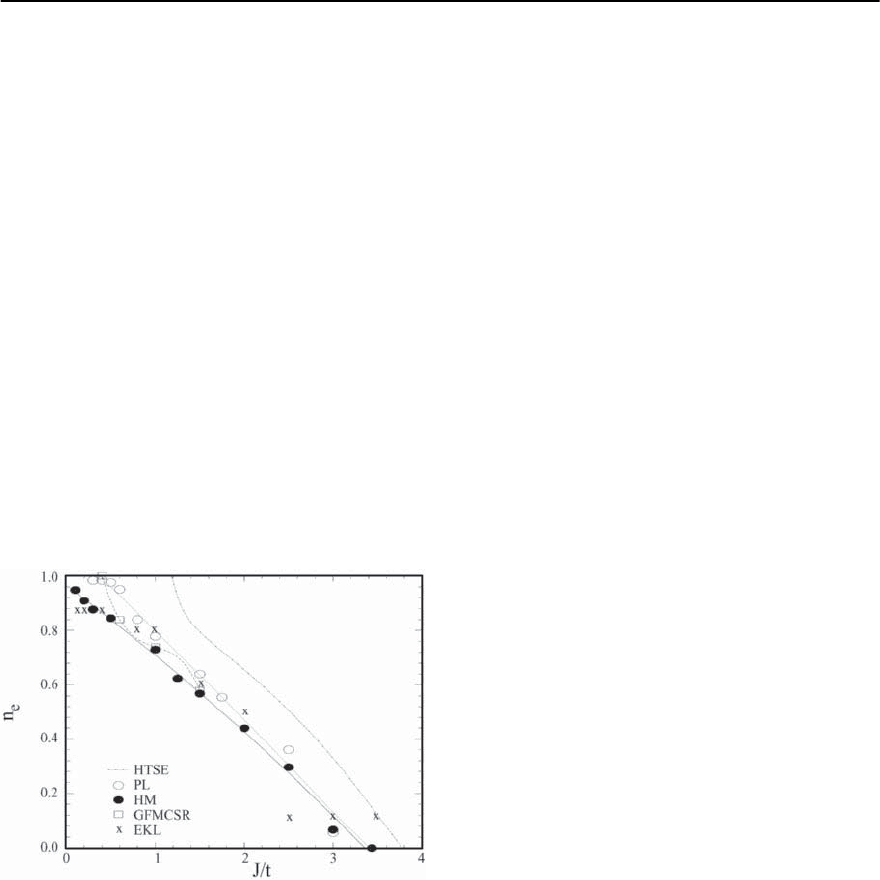
1296 E.W. Carlson et al.
open boundary conditionsin one direction by White
and Scalapino [350,351] found striped ground states
for J/t =0.35 and 0 < x < 0.3, but no indication of
phase separation.
...itseemsthat the modeliseither phaseseparated,
or very close to it.
For comparison,we have gathered a few of the results
mentioned above in Fig.21.36.The scatter of the data
at the upper left corner of the n
e
−J/t plane is a reflec-
tion of the near linearity of the ground state energy
as a function of doping in this region [359].Highnu-
merical accuracy is needed in order to establish a true
linear behavior which would be indicative of phase
separation. While there is currently no definitive an-
swer concerning phase separation at small doping, it
seems clear that in this region the two-dimensional
t − J model is in delicate balance, either in or close to
a phase separation instability.
The nature of the ground state for moderately
small J/t beyond any phase separated regime is also
Fig. 21.36. Phase separation boundary of the two-
dimensional t–J model according to various numeri-
cal studies. The dashed-dotted line represents the high
temperature series expansion results by Puttika et al.
[395]. Also shown are results from calculations using the
Power–Lanczos method by Shin et al. [400] (open cir-
cles), Greens function Monte Carlo simulations by Hellberg
and Manousakis [361] (closed circles) and by Calandra et
al.[397] (open squares), and exact diagonalization of 4 ×4
clusters by Emery et al. [392] (x’s). (Adapted from Shin et
al.[400])
in dispute. While DMRG calculations on fat ladders
[350,351] find striped ground states for J/t =0.35
and x =1/8, Monte Carlo simulations on a torus
[355] exhibit stripes only as excited states. Whether
this discrepancy is due to finite size effects or the
type of boundary conditions used is still not settled.
(The fixed node Monte Carlo studies of Becca et
al. [402] likewise conclude that stripes do not occur
in the ground state, although they can be induced by
the addition of rather modest anisotropy into the t−J
model, suggesting that they are at least energetically
competitive.)
Stripes are important low energy configurations of the
t − Jmodel.
While these conflicting conclusions may be difficult
to resolve, it seems inescapable to us that stripes
are important low energy configurations of the two-
dimensional t − J model for small doping and mod-
erately small J/t.
Typically stripes ar e quarter-filled antiphase domain
walls.
The most reliable results concerning the internal
structure of the stripes themselves come from stud-
ies of fat t − J ladders, where stripes are certainly
a prominent part of the electronic structure. In all
studies of ladders, the doped holes aggregate into
“stripes” which are oriented either perpendicular or
parallel to the extended direction of the ladder, de-
pending on boundary conditions. In many cases the
spin correlations in the hole poor regions between
stripes locally resemble those in the undoped an-
tiferromagnet but suffer a -phase shift across the
hole rich stripe. This magnetic structure is vividly
apparent in studies for which the low energy orien-
tational fluctuations of the spins are suppressed by
the application of staggered magnetic fields on cer-
tain boundary sites of the ladders—then, these mag-
netic correlationsare directly seen in the expectation
values of the spins [403]. However, such findings are
not universal: in the case of the four leg ladder, with
stripes along the ladder rungs, Arrigoni et al. [358]
recently showed that in long systems (up to 4 × 27),
these antiphase magnetic correlations are weak or
nonexistent, despite strong evidence of charge stripe
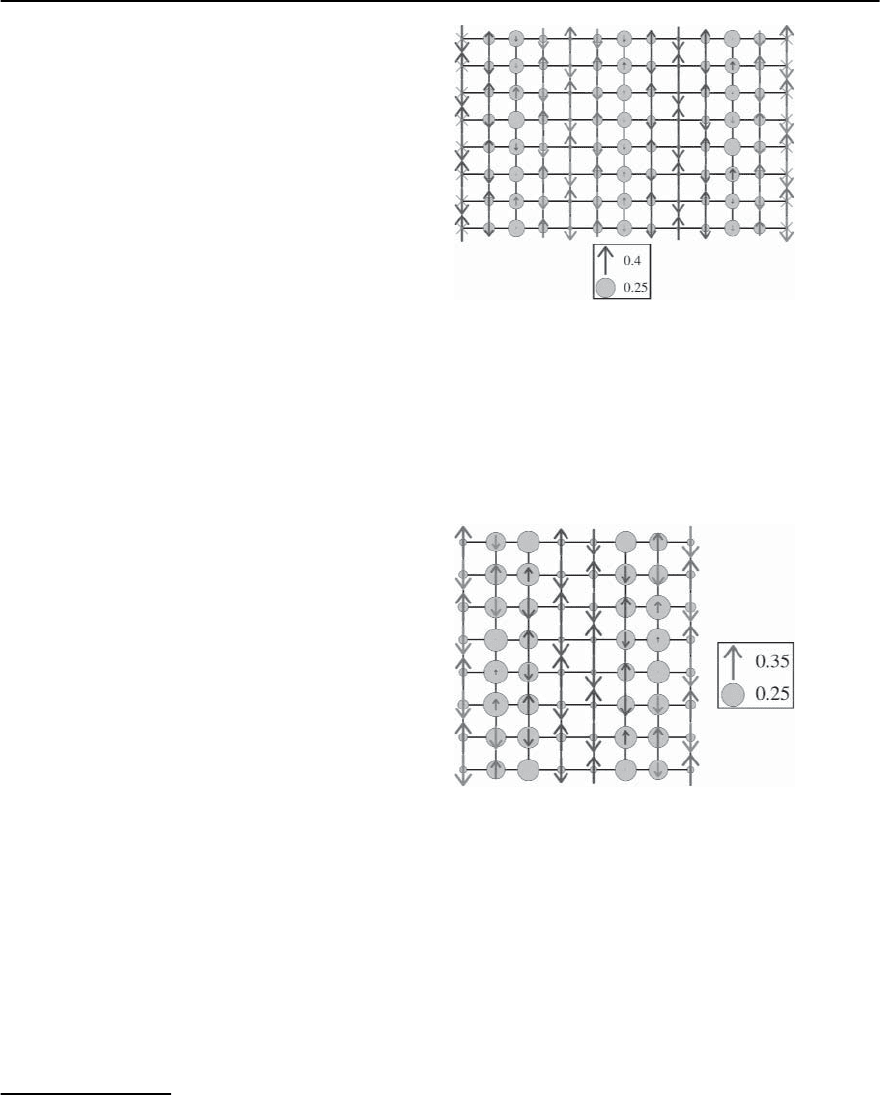
21 Concepts in High Temperature Superconductivity 1297
correlations. Ladder studies have also demonstrated
that stripes tend to favor a linear charge density of
% =1/2 along each stripe.
26
Specifically, by apply-
ing boundary conditions which force a single stripe
to lie along the long axis of the ladder, White et
al. [351] were able to study the energy of a stripe
as a function of %. They found an energy which is
apparently a smooth function of % (i.e.withnoev-
idence of a nonanalyticity which would lock % to
a specific value), but with a pronounced minimum
at % =1/2. Moreover, with boundary conditions fa-
voring stripes perpendicular to the ladder axis, they
found that for x ≤ 1/8 stripes tend to form with
% =1/2 so that the spacing between neighboring
stripes is approximately 1/2x,while at larger x,afirst
order transition occurs to“empty domain walls”with
% = 1 and an inter-stripe spacing of 1/x.Inthe re-
gion 0.125 < x < 0.17 the two types of stripes can
coexist.
It is worth noting that the original indications
of stripe order came from Hartree–Fock treatments
[405–408]. Hartree–Fock stripes are primarily spin
textures. In comparison to the DMRG results on lad-
ders, they correspond to “empty” (% = 1) antiphase
(-phaseshifted)domainwalls,and soare insulating
and overemphasize the spin component of the stripe
order, but otherwise capture much of the physics of
stripe formation remarkably accurately.
Stripes can be site- or bond-centered.
Further insight into the physics that generates the
domain walls can be gained by looking more closely
at their hole density and spin structures. Both site-
centered and bond-centered stripes are observed.
They are close in energy and each type can be sta-
bilized by adjusting the boundary conditions [350].
Figure 21.37 depicts three site-centered stripes in a
13 ×8systemwith12holes,periodicboundarycon-
ditions along the y direction and a -shifted stag-
gered magnetic field on the open ends of magnitude
0.1t. These stripes are quarter-filled antiphase do-
main walls. Figure 21.38 shows a central section of
a16× 8 cluster containing two bond-centered do-
main walls. This system is similar to the one consid-
Fig. 21.37. Hole density and spinmoments ona 13×8cylin-
der with 12 holes,J/t =0.35,periodic boundary conditions
along the y direction and -shifted staggered magnetic
field of magnitude 0.1t on the open edges. The diameter
of the circles is proportional to the hole density 1 − n
i
and the length of the arrows is proportional to S
z
i
.(From
White and Scalapino [403])
Fig. 21.38. Hole density and spin moments on a central sec-
tion of a 16 × 8 cylinder with 16 holes, J/t =0.35, with
periodic boundary conditions along the y direction and
staggered magnetic field of magnitude 0.1t on the open
edges. The notation is similar to Fig. 21.37. (From White
and Scalapino [403])
ered above except that the magnetic field on the open
ends is not -shifted. Like their site-centered coun-
terparts, the bond-centered stripes are antiphase do-
main walls, but with one hole per two domain wall
unit cells.
26
At about the same time, Nayak and Wilczek [404] presented an interesting analytic argument which leads to the same
bottom line.

1298 E.W. Carlson et al.
The topological character of spin stripes can be in-
ferred from local considerations.
The -phase shift in the exchange field across the
stripe can probably be traced, in both the bond- and
site-centered cases,to a gainin the transverse kinetic
energy of the holes. To demonstrate this point con-
sider a pair of holes in a 2 × 2 t − J plaquette, as
was done in Sect. 21.10.3.One can simulate the effect
of the exchange field running on both sides of the
plaquette through a mean field h which couples to
the spins on the square [403]. For the in-phase do-
main wall such a coupling introduces a perturbation
h(S
z
1
−S
z
2
−S
z
3
+S
z
4
) which, to lowest order in h,lowers
the ground state energy by −h
2
/
√
J
2
+32t
2
.Forthe
-shifted stripe the perturbation is h(S
z
1
+S
z
2
−S
z
3
−S
z
4
)
with a gain of −4h
2
/
√
J
2
+32t
2
in energy, thereby
being more advantageous for the pair. Indeed, this
physics has been confirmed by several serious stud-
ies, which combine analytic and numerical work, by
Zachar [409], Liu and Fradkin [410], and Cherny-
shev et al. [411] (see also [445]). These studies in-
dicate that there is a transition from a tendency for
in-phase magnetic order across a stripe for small %,
when the direct magnetic interactionsare dominant,
to antiphase magnetic order for % > 0.3, when the
transverse hole kinetic energy is dominant.
In contrast to the t − J model there have
been relatively few numerical studies of large two-
dimensional Hubbard model clusters. Monte Carlo
simulations [360,412,413]of systems of up to 16×16
sites have reached somewhat conflictingconclusions.
Whilevariational“fixednode”calculations by Cosen-
tini et al. [412] are suggestive of phase separation
at small x, the work of Becca et al. [413] claims a
spatially homogeneous ground state up to values of
U/t = 10.Such findings are in conflict with the very
latest DMRG studies of 6-leg Hubbard ladders.
Stripes appear to be a robust feature of fat Hubbard
ladders at strong coupling
White and Scalapino [414] have shown that a narrow
stripe appears in the ground state of a 7 ×6-siteclus-
ter with average hole density x ≈ 0.095 for U/t ≥ 6.
For weaker couplings the hole and spin densities
show structures which were interpreted as a broad
stripe.In a recenttour de forceDMRG study by Hager
et al.[415]6-leg Hubbardladders with x ≈ 0.095 and
lengths of up to 28 sites were studied with careful
analysis of numerical errors and finite size scaling.
This work gives strong evidence that stripes exist
andarerobustinthegroundstateofthe6-legHub-
bard ladder for strong coupling (U/t = 12), while
the structures found at weaker coupling (U/t =3)
are probably an artifact of the DMRG approach.
The properties found in the studies of stripes in
the t − J model, such as them being anti-phase do-
main walls in the antiferromagneticbackgroundand
the near-degeneracy in energy between site-centered
and bond-centered stripes, have been demonstrated
in the context of the Hubbard ladder as well.
Superconductivity and Stripes
ThereisnoevidenceforsuperconductivityintheHub-
bard model.
There is no unambiguous evidence for superconduc-
tivity in the Hubbardmodel.The originalfinite tem-
perature Monte Carlo simulations on small periodic
clusters with U/t =4andx =0.15 [360,416] found
only short range pair-pair correlations. The same
conclusion was reached by a later zero temperature
constrained path Monte Carlo calculation [417]. The
above mentioned DMRG studies of the 6-leg Hub-
bard ladder did not include a calculation of the pair-
ing correlations in this system. However, if the ro-
bust static charge-density-wave correlations found
in the ladder persist in the two-dimensional model it
is likely that they work against the establishment of
long-range superconducting order in the plane.
There are conflicting results concerning the ques-
tion of superconductivity in the t − J
mo
del.
In the unphysical region of large J/t, solid conclu-
sions can be reached: Emery et al. [392] have shown
that proximate to the phase separation boundary at
J/t ≤ 3.8,the hole rich phase (which is actually a di-
lute electron phase with x ∼ 1) has an s-wave super-
conducting ground state. This result was confirmed
and extended by Hellberg and Manousakis [352],
who further argued that in the dilute electron limit,
x → 1
−
, there is a transition from an s-wave state for
2 < J/t < 3.5toap-wave superconducting state for
J/t < 2, possibly with a d-wave state at intermedi-
ate J/t.
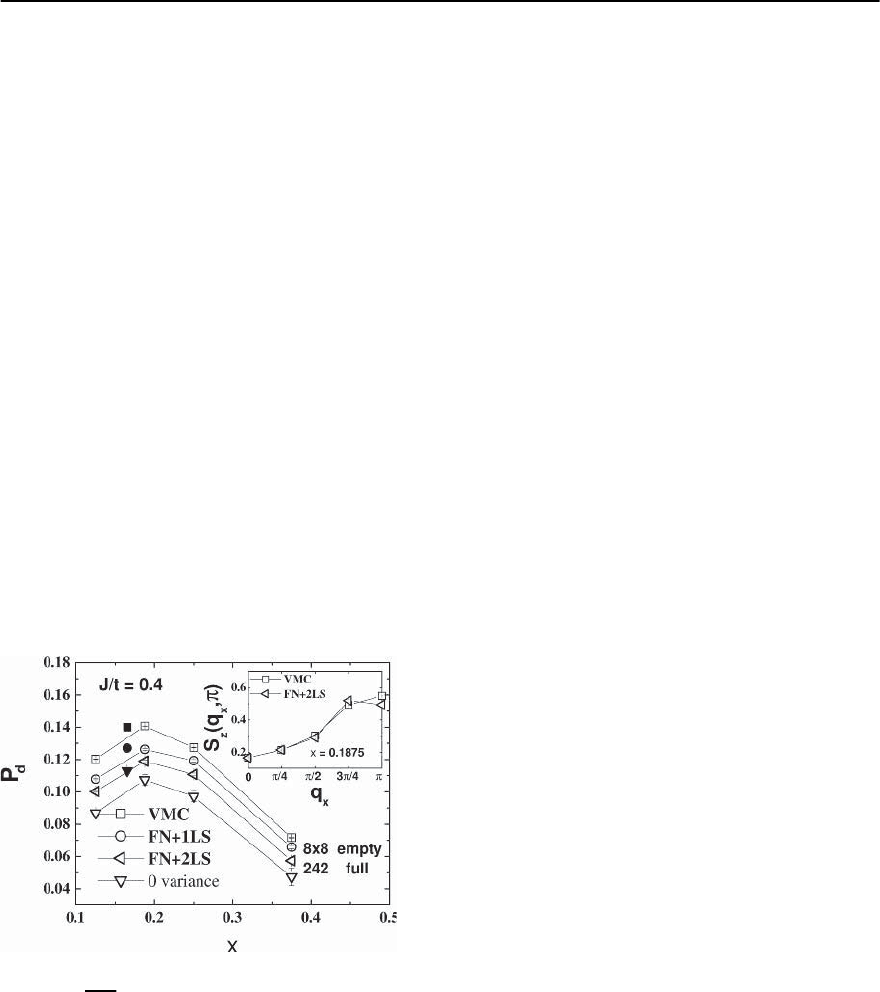
21 Concepts in High Temperature Superconductivity 1299
There is conflicting evidence for superconductivity in
the t − Jmodel.
Early Lanczos calculations were carried out by
Dagotto and Riera [360, 418,419] in which various
quantities,suchas the pair field correlation function
and the superfluid density, were computed to search
for signs of superconductivity in 4 ×4 t − J clusters.
In agreement with the analytic results, these studies
gave strong evidence of superconductivity for large
J/t. Interestingly, the strongest signatures of super-
conductivity were found for J/t =3andx =0.5and
decayed rapidly for larger J/t. This was interpreted
as due to a transition into the phase separation re-
gion.(Note,however,thatall the studies summarized
in Fig. 21.36 suggest that x =0.5 is already inside the
region that, in the thermodynamic limit, would be
unstable to phase separation.)
More recent Green’s function Monte Carlo simu-
lations by Sorella et al. [420,421] showed evidence
for long range superconducting order in J/t =0.4
clusters of up to 242 sites with periodic boundary
conditions and for a range of x > 0.1, as shown in
Fig. 21.39. No signs of static stripes have been found
in the parameter region that was investigatedin these
studies. A slight tendency towards incommensura-
Fig. 21.39. The superconducting order parameter P
d
=
2lim
l→∞
√
D(l) calculated for the largest distance on a
8 × 8, J/t =0.4 cluster as function of hole doping x.Re-
sults for x =0.17 on a 242 site cluster are also shown. The
different sets of data correspond to various Monte Carlo
techniques. The inset shows the spin structure factor at
x =0.1875. (From Sorella et al.[421])
bility appears in the spin structure factor at (and
sometimes above) optimal doping, suggesting per-
haps very weak dynamical stripe correlations. Both
the evidence for superconductivity and the absence
of stripes in this study are in conflict with the re-
sults of other studies, and it was suggested [422,423]
that the choice of the guiding trial wave function for
the calculation may bias the system towards a su-
perconducting state. For example, Shih et al. [400]
have shown that the pair binding energy on small
clusters decreases with cluster size, and extrapolates
to positive values in the thermodynamic limit for
J/t < 0.8. (A similar conclusion was reached earlier
by Boninsegni and Manousakis [424].) Stripe ground
states were found for the same values of parameters
in DMRG [350,351] and other calculations [425].
Static st ripes hamper superconductivity, but dynamic
stripes may enhance it.
Notwithstanding this controversy, these results seem
to add to the general consensus that static stripe or-
der and superconductivity compete. This is not to
say that stripes and superconductivity cannot coex-
ist. As we saw, evidence for both stripes and pair-
ing have been found in three and four leg t − J lad-
ders [379, 381]. In fact pairing is enhanced in both
of these systems when stripes are formed compared
to the unstriped states found at small doping levels.
Because of the open boundary conditions that were
used in these studies the stripes were open ended and
more dynamic. Imposing periodic boundary condi-
tions in wider ladders (and also the four leg ladder)
results in stripes that wrap around the periodic di-
rection. These stripes appear to be more static, and
pairing correlationsare suppressed.A similar behav-
ior is observed when the stripes are pinned by exter-
nal potentials.
Furtherevidenceforthedelicateinterplaybe-
tween stripes and pairing comes from studies of the
t − t
− J model in which a diagonal, single parti-
cle, next nearest neighbor hopping t
is added to the
basic t − J model [354,425]. Stripes destabilize for
either sign of t
.This is probably due to the enhanced
mobility of the holes that can now hop on the same
sublattice without interfering with the antiferromag-
netic background. Pairing is suppressed for t
< 0
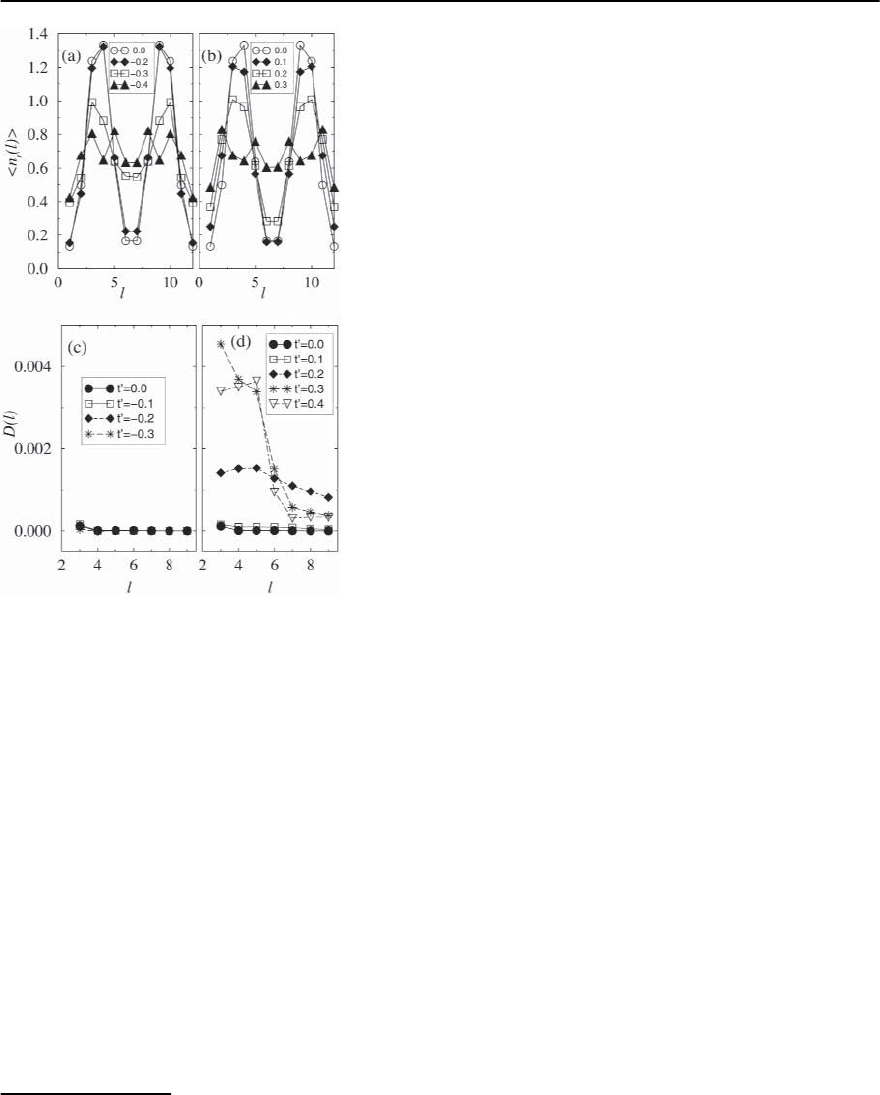
1300 E.W. Carlson et al.
Fig. 21.40. Hole density per rung for a 12 × 6 ladder with
periodic boundary conditions along the rungs, 8 holes,
J/t =0.35 and (a) t
≤ 0and(b) t
≥ 0. (c)and(d)de-
pict the d-wave pairing correlations for the same systems.
(From White and Scalapino [354])
and enhanced for t
> 0.
27
It is not clear whether
the complete elimination of stripes or only a slight
destabilization is more favorable to pairing correla-
tions. Figure 21.40 suggests that optimal pairing oc-
curs in between the strongly modulated ladder and
the homogeneous system.
Finally, allowing for extra hopping terms in the
Hamiltonian is not the only way tip the balance be-
tween static charge order and superconductivity. So
far we have not mentioned the effects of long range
Coulomb interactions on the properties of Hubbard
related systems. This is not a coincidence since the
treatment of such interactions in any standard nu-
merical method is difficult. Nevertheless, a recent
DMRG study of four leg ladders with open and peri-
odic boundary conditions which takes into account
the Coulomb potential in a self-consistent Hartree
way [358], gives interesting results. It suggests that
the inclusion of Coulomb interactions suppresses the
charge modulations associated with stripes while en-
hancing the long range superconducting pairing cor-
relations.At the same time the local superconducting
pairing is not suppressed.Taken together,these facts
support the notion that enhanced correlations come
from long range phase ordering between stripes with
well-established pairing. This enhanced phase stiff-
ness is presumably due to pair tunneling between
stripes produced by increased stripe fluctuations.
21.12 Doped Antiferromagnets
The undoped state of the cuprate superconductors
is a strongly insulating antiferromagnet. It is now
widely believed that the existence of such a parent
correlated insulator is an essential feature of high
temperature superconductivity, as was emphasized
in someof the earliest studies of this problem[5,120].
However,the dopedantiferromagnet is a complicated
theoretical problem—to even cursorily review what
is known about it would more than double the size
of this document. In this section we very briefly dis-
cuss the aspects of this problem which we consider
most germane to the cuprates, and in particular to
the physics of stripes. More extensive reviews of the
subject can be found in [6,15,390,426].
21.12.1 Frustration of the Motion of Dilute Holes in an
Antiferromagnet
The most important local interactions in a doped
antiferromagnet are well represented by the large U
Hubbard model,the t −J model,and their various rel-
atives. To be concrete, we will focus on the t − J − V
model [393] (aslight generalizationof thet−J model,
Eq. (21.119), to which it reduces for V =−J/4.)
27
This is surprising since T
c
is generally higher for hole doped cuprates (believed to have t
< 0) than it is for electron
doped cuprates (which have t
> 0).
